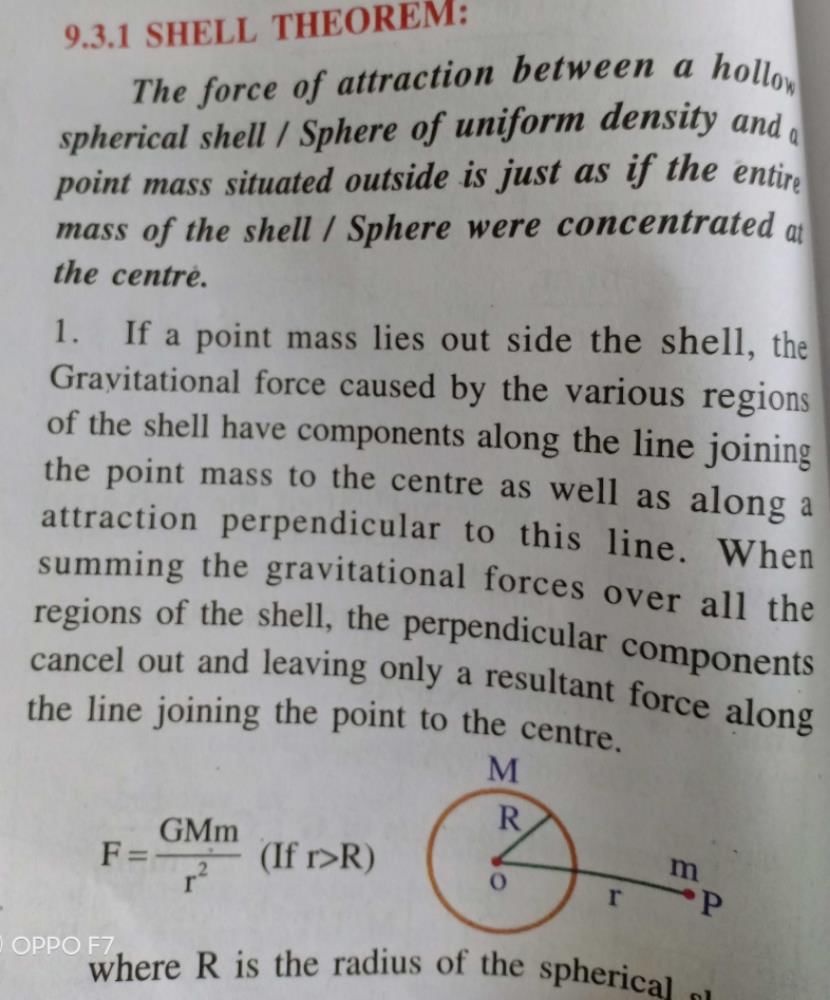Class 11 Exam > Class 11 Questions > Describe Newton's shell theorem?
Start Learning for Free
Describe Newton's shell theorem?
Most Upvoted Answer
Describe Newton's shell theorem?
Newton's Shell Theorem
Newton's shell theorem is a fundamental principle in physics that describes the gravitational forces exerted by a spherically symmetric object on objects outside of it. It is based on Newton's law of gravity, which states that the force between two objects is proportional to the product of their masses and inversely proportional to the square of the distance between them.
The Theorem
The shell theorem states that a spherically symmetric object exerts the same gravitational force on an object outside of it as if all of its mass were located at its center. This means that if a spherically symmetric object is hollow, with all of its mass concentrated on its surface, the gravitational force it exerts on an object outside of it is zero.
Explanation
The shell theorem can be explained using the following steps:
1. Divide the spherically symmetric object into thin, concentric shells.
2. Calculate the gravitational force exerted by each shell on the object outside of it using Newton's law of gravity.
3. Sum up the forces from all the shells to find the total force exerted by the object.
Applications
The shell theorem has several applications in physics, including:
1. It helps in understanding the behavior of planets and stars, which are approximately spherically symmetric.
2. It is used in the design of spacecraft trajectories, as it allows for accurate predictions of gravitational forces.
3. It is used in the study of black holes, which are highly symmetric objects with extremely strong gravitational fields.
Conclusion
Newton's shell theorem is a powerful tool for understanding the gravitational forces exerted by spherically symmetric objects. It allows for accurate predictions of gravitational forces and has several applications in physics.
Newton's shell theorem is a fundamental principle in physics that describes the gravitational forces exerted by a spherically symmetric object on objects outside of it. It is based on Newton's law of gravity, which states that the force between two objects is proportional to the product of their masses and inversely proportional to the square of the distance between them.
The Theorem
The shell theorem states that a spherically symmetric object exerts the same gravitational force on an object outside of it as if all of its mass were located at its center. This means that if a spherically symmetric object is hollow, with all of its mass concentrated on its surface, the gravitational force it exerts on an object outside of it is zero.
Explanation
The shell theorem can be explained using the following steps:
1. Divide the spherically symmetric object into thin, concentric shells.
2. Calculate the gravitational force exerted by each shell on the object outside of it using Newton's law of gravity.
3. Sum up the forces from all the shells to find the total force exerted by the object.
Applications
The shell theorem has several applications in physics, including:
1. It helps in understanding the behavior of planets and stars, which are approximately spherically symmetric.
2. It is used in the design of spacecraft trajectories, as it allows for accurate predictions of gravitational forces.
3. It is used in the study of black holes, which are highly symmetric objects with extremely strong gravitational fields.
Conclusion
Newton's shell theorem is a powerful tool for understanding the gravitational forces exerted by spherically symmetric objects. It allows for accurate predictions of gravitational forces and has several applications in physics.
Community Answer
Describe Newton's shell theorem?


|
Explore Courses for Class 11 exam
|

|
Question Description
Describe Newton's shell theorem? for Class 11 2025 is part of Class 11 preparation. The Question and answers have been prepared according to the Class 11 exam syllabus. Information about Describe Newton's shell theorem? covers all topics & solutions for Class 11 2025 Exam. Find important definitions, questions, meanings, examples, exercises and tests below for Describe Newton's shell theorem?.
Describe Newton's shell theorem? for Class 11 2025 is part of Class 11 preparation. The Question and answers have been prepared according to the Class 11 exam syllabus. Information about Describe Newton's shell theorem? covers all topics & solutions for Class 11 2025 Exam. Find important definitions, questions, meanings, examples, exercises and tests below for Describe Newton's shell theorem?.
Solutions for Describe Newton's shell theorem? in English & in Hindi are available as part of our courses for Class 11.
Download more important topics, notes, lectures and mock test series for Class 11 Exam by signing up for free.
Here you can find the meaning of Describe Newton's shell theorem? defined & explained in the simplest way possible. Besides giving the explanation of
Describe Newton's shell theorem?, a detailed solution for Describe Newton's shell theorem? has been provided alongside types of Describe Newton's shell theorem? theory, EduRev gives you an
ample number of questions to practice Describe Newton's shell theorem? tests, examples and also practice Class 11 tests.

|
Explore Courses for Class 11 exam
|

|
Signup for Free!
Signup to see your scores go up within 7 days! Learn & Practice with 1000+ FREE Notes, Videos & Tests.


















